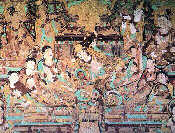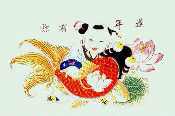Chinese traditional painting dates back to the Neolithic Age about 6,000 years ago. The excavated colored pottery with painted human faces, fish, deer and frogs indicates that the Chinese began painting as far back as the Neolithic Age. Over the centuries, the growth of Chinese painting inevitably reflected the change of time and social conditions.
From Primitive to Modern
 |
| A painted pottery basin |
In its earliest stage, Chinese prehistoric paintings were closely related to other primitive crafts, such as pottery, bronzeware, carved jade and lacquer. The line patterns on unearthed pottery and bronzeware resemble ripples, fishing nets, teeth or frogs. The animal and human figures, succinct and vivid, are proofs to the innate sensitivity of the ancient artists and nature.
 |
| A rock painting |
Following the introduction of Buddhism to China during the first century from India, and the carvings on grottoes and temple building that ensued, the art of painting religious murals gradually gained prominence.
 |
| Grotto mural in Dunhuang |
The Tang Dynasty (618-907) witnessed the prosperity of figure painting, where the most outstanding painters were Zhang Xuan and Zhou Fang. Their paintings, depicting the life of noble women and court ladies, exerted an eternal influence on the development of shi nu hua (painting of beauties), which comprise an important branch of traditional Chinese painting today.
|
|
| Painting of beauties |
 |
| Landscape painting |
When the Manchus came to power in 1644, the then-best painters showed their resentment to the Qing (1644-1911) court in many ways. The "Four Monk Masters" -- Zhu Da, Shi Tao, Kun Can and Hong Ren -- had their heads shaved to demonstrate their determination not to serve the new dynasty, and they soothed their sadness by painting tranquil nature scenes and traditional art.
Yangzhou, which faces Suzhou across the Yangtze River, was home to the "Eight Eccentrics" - the eight painters all with strong characters, proud and aloof, who refused to follow orthodoxy. They used freehand brushwork and broadened the horizon of flower-and-bird painting.
By the end of the Qing Dynasty and the beginning of the Republic of China, Shanghai, which gave birth to the Shanghai Painting School, had become the most prosperous commercial city and a gathering place for numerous painters. Following the spirit of the Eight Eccentrics of Yangzhou, the Shanghai School played a vital role in the transition of Chinese traditional painting from a classical art form to a modern one.
The May 4th Movement of 1919, or the New Culture Movement, inspired the Chinese to learn from western art and introduce it to China. Many outstanding painters, led by Xu Beihong, emerged, whose paintings recognized a perfect merging of the merits of both Chinese and Western styles, absorbing western classicism, romanticism and impressionism. Other great painters of this period include Qi Baishi, Huang Binhong and Zhang Daqian.
Oil painting, a western art, was introduced to China in the 17th century and gained popularity in the early 20th century. In the 1980s Chinese oil painting boomed.
 |
| New Year Painting |











